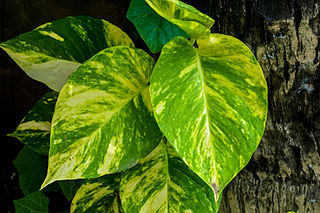
Epipremnum aureum is a species of flowering plant in the arum family Araceae, native to Mo'orea in the Society Islands of French Polynesia. The species is a popular houseplant in temperate regions, but has also become naturalised in tropical and sub-tropical forests worldwide, including northern Australia, Southeast Asia, South Asia, the Pacific Islands and the West Indies, where it has caused severe ecological damage in some cases.

Dendrobium is a genus of mostly epiphytic and lithophytic orchids in the family Orchidaceae. It is a very large genus, containing more than 1,800 species that are found in diverse habitats throughout much of south, east and southeast Asia, including China, Japan, India, the Philippines, Indonesia, Australia, New Guinea, Vietnam and many of the islands of the Pacific. Orchids in this genus have roots that creep over the surface of trees or rocks, rarely having their roots in soil. Up to six leaves develop in a tuft at the tip of a shoot and from one to a large number of flowers are arranged along an unbranched flowering stem. Several attempts have been made to separate Dendrobium into smaller genera, but most have not been accepted by the World Checklist of Selected Plant Families.

Nyctanthes arbor-tristis, the night-flowering jasmine or Parijat or hengra bubar or Shiuli is a species of Nyctanthes native to South Asia and Southeast Asia.
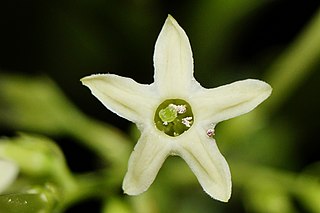
Cestrum nocturnum, the lady of the night, night-blooming jessamine, night-scented jessamine, night-scented cestrum or poisonberry, is a species of plant in the potato family Solanaceae. It is native to the West Indies, but naturalized in South Asia.
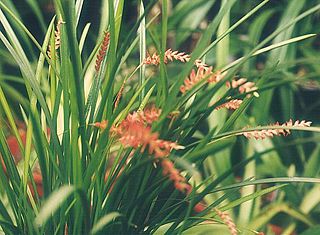
Dendrochilum is a genus of epiphytic, lithophytic and a few terrestrial flowering plants in the orchid family (Orchidaceae). The name of this genus is derived from Ancient Greek words dendron ("tree"), and either cheilos ("lip") or chilos, alluding to either the flowers' large lip or to their epiphytic growth. These orchids are popular among fans of non-traditional orchid curiosities.

Lavandula angustifolia, formerly L. officinalis, is a flowering plant in the family Lamiaceae, native to the Mediterranean. Its common names include lavender, true lavender or English lavender ; also garden lavender, common lavender, and narrow-leaved lavender.
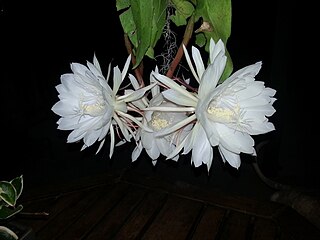
Epiphyllum oxypetalum is a species of cactus and one of the most cultivated species in its genus. E. oxypetalum rarely blooms and only at night, and its flowers wilt before dawn. Though it is sometimes referred to as a night-blooming cereus, it is not closely related to any of the species in the tribe Cereeae, such as Selenicereus, that are more commonly known as nightblooming cereus. All Cereus species bloom at night and are terrestrial plants; Epiphyllum species are usually epiphytic.

Anemone hepatica, the common hepatica, liverwort, kidneywort, or pennywort, is a species of flowering plant in the buttercup family Ranunculaceae, native to woodland in temperate regions of the Northern Hemisphere. This herbaceous perennial grows from a rhizome.

Alstonia scholaris, commonly called blackboard tree or devil's tree in English, is an evergreen tropical tree in the family Apocynaceae. It is native to southern China, tropical Asia and Australasia.

Dendrobium lindleyi, also known as Dendrobium aggregatum, is a plant of the genus Dendrobium. They are found in the mountains of southern China and Southeast Asia.

Dendrobium kingianum, commonly known as the pink rock orchid, is a flowering plant in the orchid family Orchidaceae and is endemic to eastern Australia. It usually grows on rocks, rarely as an epiphyte, and has thin, spreading leaves and spikes of up to fifteen, usually pink flowers in late winter to spring. It is popular in Australian native horticulture and is a commonly cultivated orchid among Australian orchid species growers.

Dendrobium nobile, commonly known as the noble dendrobium, is a member of the family Orchidaceae. It has become a popular cultivated decorative house plant, because it produces colourful blooms in winter and spring, at a time when little else is in flower. It is also one of the 50 fundamental herbs used in traditional Chinese medicine, known as shí hú or shí hú lán. Dendrobium nobile is one of the most widespread ornamental members of the orchid family. Its blooms are variegated in colour, shading from white through pink and purple, and the many different cultivated varieties produce different sized and coloured blooms.

Dendrobium validicolle is a species of orchid. Its common name is the strong-stemmed diplocaulobium.

Dendrobium bigibbum, commonly known as the Cooktown orchid or mauve butterfly orchid, is an epiphytic or lithophytic orchid in the family Orchidaceae. It has cylindrical pseudobulbs, each with between three and five green or purplish leaves and arching flowering stems with up to twenty, usually lilac-purple flowers. It occurs in tropical North Queensland, Australia and New Guinea.

Dendrobium gracilicaule, commonly known as the blotched cane orchid or yellow cane orchid, is an epiphytic or lithophytic orchid in the family Orchidaceae. It has cylindrical pseudobulbs, between three and seven thin leaves and up to thirty often drooping, cream-coloured to yellow or greenish flowers, sometimes with reddish brown blotches on the back. There are two varieties, one occurring in Queensland and New South Wales and the other on some Pacific Islands, including Lord Howe Island.

Nymphaea nouchali, often known by its synonym Nymphaea stellata, or by common names blue lotus, star lotus, red and blue water lily, blue star water lily or manel flower is a water lily of genus Nymphaea. It is native to southern and eastern parts of Asia, and is the national flower of Bangladesh and Sri Lanka. In Sanscrit it is utpala. This species is sometimes considered to include the blue Egyptian lotus Nymphaea caerulea. In the past, taxonomic confusion has occurred, with the name Nymphaea nouchali incorrectly applied to Nymphaea pubescens.
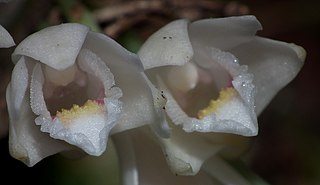
Dendrobium milaniae is flower of the Orchid family found in Leyte, Visayas in the Philippines, where it is found growing as an epiphyte above bodies of water at elevations up to 600 metres. The flower grows to approximately 1.5 centimetres (0.59 in). The plant is semi-pendulous and sympodial. Pseudobulbs are 10 cm by 2 cm; 3 to 6 green lanceolate leaves are present on the top third of the pseudobulb. Hans Fessel and Emil Lückel named this species in 1996 in Die Orchidee.

Dendrobium bullenianum is a member of the family Orchidaceae found in the Philippines and Vietnam. It is named in honor of Mr. Bullen, orchid cultivator with Low & Co.'s nursery, who was first in Britain get this species to flower in cultivation. It is pendulous and sympodial with 1 meter long pseudobulbs of 1.5 cm thickness and deciduous leaves of 10 cm by 1.5 cm. Heinrich Gustav Reichenbach was the first to describe this species in 1862 in Botanische Zeitung. It is found as an epiphyte in elevations up to 1,000 metres in Luzon and Mindoro in the Philippines.
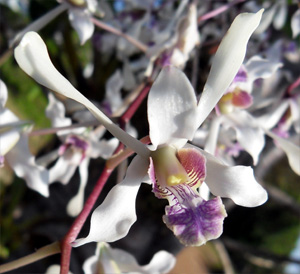
Dendrobium lineale is a species of orchid. It is an epiphytic plant that grows along the north-eastern coast of New Guinea, from Milne Bay to just over the border into the Indonesian Province of Papua, and from sea level to around 800 metres (2,600 ft). It has cane-like pseudobulbs which grow up to 2 metres long and 2–3 centimetres (0.8–1.2 in) in diameter. Its inflorescences are up to 75 cm (30 in) long with many flowers, up to 5 cm (2.0 in) across. Its leaves are oblong or lanceolate, and up to 15 cm (6 in) long. They last two to three months and bloom throughout the year in the native habitat.
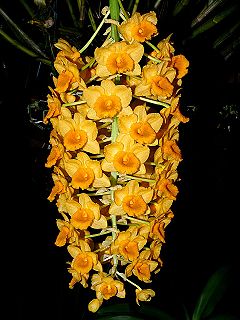
Dendrobium densiflorum is a species of epiphytic or lithophytic orchid, native to Asia. It has club-shaped stems, three or four leathery leaves and densely flowered, hanging bunches of relatively large pale yellow and golden yellow flowers.




















